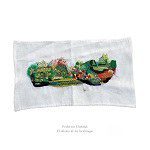Jana Winderen; Thomas Köner; Dronny Darko; Alphaxone
The sound of plankton as recorded by Jana Winderen – Thomas Köner’s tribute to the Light – inward/outward journeys by Dronny Darko and Alphaxone.
The sound of plankton as recorded by Jana Winderen – Thomas Köner’s tribute to the Light – inward/outward journeys by Dronny Darko and Alphaxone.
In the Shortlist sections, I will mention the albums that I enjoyed listening to, but couldn’t find the time (or the right words) for a “full” review for. Still, I definitely think they deserve your attention, with ór without extra words!

FEDERICO DURAND – EL IDIOMA DE LAS LUCÉRNAGAS

“El Idioma de las Lucérnagas” translates as “The Language of Fireflies”, which is a most appropriate description for this album full of environmental soundscapes and peaceful associations.
“When Durand opens up his music box, the crickets breathe through it. ‘El idioma de las luciernagas’ creates a place where wind chimes, stray guitars, and dropped thoughts fall like rain. The music makes me think of eyes as olives and wonder what they would see. These are microambient sounds because they puncture air holes in the glass jar of the world and we can breathe through it, pausing and passing through the punctuation that makes the language of fireflies a language of light.“
The Hibernate recordings label continues to release a steady stream of great music.
One of their project series is the ‘Postcard Series’ – beautiful music on EP albums (about 20 minutes each), attached to limited edition numbered postcards.
One thing you’ll have to get used to, however, is that the physical editions sell out at the speed of light!
But, luckily, download versions of the releases stay available when the physical releases have run out!
[Check the links below for full streams of the album tracks]
When I started working on this ‘single artist mix’ featuring music and sounds from Arno Peeters, I did not realise that creating a mix-collage based on soundscapes would be more difficult than one based on single tracks.
A soundscape is a collage in itself – and using fragments from soundscapes to build another soundscape is like ripping up a collage and presenting the fragmented details out of their original context, rearranging them to create a new caleidoscopic image.
The original context gets lost, and the result feels like an aural stream of consciousness that may not exactly be “easy on the ears” …. but may prove to be a fascinating exploration of imaginary territories..